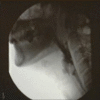Dental management in dysphagia syndrome patients with previously acquired brain damages
- PMID: 23162574
- PMCID: PMC3491320
Dental management in dysphagia syndrome patients with previously acquired brain damages
Abstract
Dysphagia is defined as difficulty in swallowing food (semi-solid or solid), liquid, or both. Difficulty in swallowing affects approximately 7% of population, with risk incidence increasing with age. There are many disorder conditions predisposing to dysphagia such as mechanical strokes or esophageal diseases even if neurological diseases represent the principal one. Cerebrovascular pathology is today the leading cause of death in developing countries, and it occurs most frequently in individuals who are at least 60 years old. Swallowing disorders related to a stroke event are common occurrences. The incidence ranging is estimated from 18% to 81% in the acute phase and with a prevalence of 12% among such patients. Cerebral, cerebellar, or brain stem strokes can influence swallowing physiology while cerebral lesions can interrupt voluntary control of mastication and bolus transport during the oral phase. Among the most frequent complications of dysphagia are increased mortality and pulmonary risks such as aspiration pneumonia, dehydration, malnutrition, and long-term hospitalization. This review article discusses the epidemiology of dysphagia, the normal swallowing process, pathophysiology, signs and symptoms, diagnostics, and dental management of patients affected.
Keywords: Deglutition disorders; epidemiology; stroke.
Conflict of interest statement
Figures










Similar articles
-
Assessment and early diagnosis of dysphagia.Geriatr Nurs. 2008 Nov-Dec;29(6):376-83. doi: 10.1016/j.gerinurse.2007.12.001. Geriatr Nurs. 2008. PMID: 19064135 Review.
-
Prediction of outcome in neurogenic oropharyngeal dysphagia within 72 hours of acute stroke.J Stroke Cerebrovasc Dis. 2012 Oct;21(7):569-76. doi: 10.1016/j.jstrokecerebrovasdis.2011.01.004. Epub 2011 Jun 16. J Stroke Cerebrovasc Dis. 2012. PMID: 21683618
-
[Causes, diagnosis and treatment of neurogenic dysphagia as an interdisciplinary clinical problem].Otolaryngol Pol. 2006;60(4):491-500. Otolaryngol Pol. 2006. PMID: 17152798 Review. Polish.
-
Nutritional Aspects of Dysphagia Management.Adv Food Nutr Res. 2017;81:271-318. doi: 10.1016/bs.afnr.2016.11.008. Epub 2016 Dec 23. Adv Food Nutr Res. 2017. PMID: 28317607 Review.
-
Dysphagia.2023 Nov 18. In: StatPearls [Internet]. Treasure Island (FL): StatPearls Publishing; 2025 Jan–. 2023 Nov 18. In: StatPearls [Internet]. Treasure Island (FL): StatPearls Publishing; 2025 Jan–. PMID: 32644600 Free Books & Documents.
Cited by
-
Nutritional Supplements and Neuroprotective Diets and Their Potential Clinical Significance in Post-Stroke Rehabilitation.Nutrients. 2021 Aug 5;13(8):2704. doi: 10.3390/nu13082704. Nutrients. 2021. PMID: 34444864 Free PMC article. Review.
-
Translation and Validation of the Dysphagia Handicap Index in Polish-Speaking Patients.Dysphagia. 2023 Aug;38(4):1200-1211. doi: 10.1007/s00455-022-10545-y. Epub 2022 Dec 12. Dysphagia. 2023. PMID: 36507957 Free PMC article.
References
-
- Wieseke A, Bantz D, Siktberg L, Dillard N. Assessment and early diagnosis of dysphagia. Geriatr Nurs. 2008;29:376–83. - PubMed
-
- Nazarko L. The clinical management of dysphagia in primary care. (260, 262-4).Br J Community Nurs. 2008;13:258. - PubMed
-
- Squires N. Dysphagia management for progressive neurological conditions. Nurs Stand. 2006;20:53–7. - PubMed
-
- González-Fernández M, Daniels SK. Dysphagia in stroke and neurologic disease. Phys Med Rehabil Clin N Am. 2008;19:867–88. x. - PubMed
LinkOut - more resources
Full Text Sources
